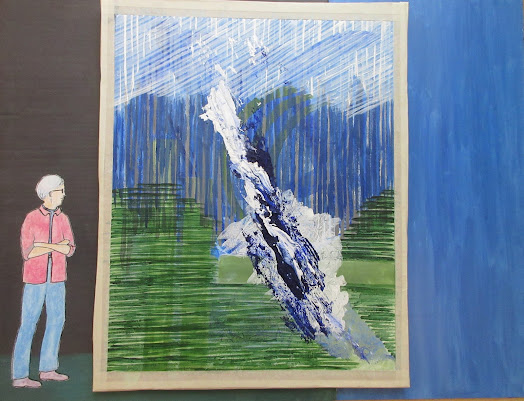I was walking from the bus stop to the dentist one fine day in June, not long after the "Hydration" theme had occurred to me.
I knew from previous trips that something watery happened at this intersection. This time, I stopped to pay attention to the interpretive marker.
Wow! Lots of tidbits here for a research expedition. I later found that whole websites and history organizations (yes, small ones) are devoted to Brewery Creek and its special claim on an era in Vancouver history. Let's start with a map from 118 years ago this month.
Giving credits where due, I'll say that this map makes no sense at all until you come to realize that compass North is on the right. Then, in association with this battered photo image on the marker, you can almost feel the water flowing around you.
So here we are, standing on a footbridge. One of those websites informed me that Vancouver's two major industries in that era were sawmills and – yes, breweries. For the big picture, let's move to a bigger picture of all the old-time streams flowing down northward to sea level (eventually) from the height of Vancouver's east-west spine.
This will be our blueprint of sorts for Summer Camp's "Hydration Series." If you squint, you might just see a small red arrow (my addition) that points to our current Brewery Creek location.
Meanwhile, what about abstract art, the designated vehicle for this series? Even more than usual, I've recently been mulling about art in general. On a later day, I went back to the triangular coffee shop located at that intersection, just about in the old footbridge location.
Climbing over a few stools, I parked myself and my coffee at the very point of the shop – and found myself thinking of …Cezanne? How did he get in here?
A Cezanne viaduct. Okay. And there aren't many artists past or present who have given as much thought to what art is. I remembered almost verbatim his observation, which is more specifically illustrated here:
"Everything in Nature is modeled like spheres, cones and cylinders. We must learn to paint based on these simple forms and only then will we be able to do everything we want."
Was all this becoming too much like Summer School rather than Summer Camp? Not at all. Maybe it was the cinnamon bun with the caffeine rush that gave me the perfect blend of Brewery Creek and abstract art. I had my title. I would just have to follow through:
"A cylinder, a sphere, and a cone walked into a bar…"
Back in the studio, I assembled a few small paper supports and also my old collection of gouache paints. It was a bit tricky with a very small brush on about 3x5" paper. The first version was simply white on black.
Next up, the same image using just a few colours.
And at this point, a funny thing happened. My memory bank was surfacing an abstract painter who worked similarly with thickened directional lines and basic geographic elements. Haha – notice how I've put myself in the same league! Let's see. His name started with an "M." YES! – Malevich. Don't you think we could hang on the same wall together? This painting of his is titled "Wide Walls" so there's certainly room enough.
I was quite chuffed, as the Brits would say. I made one last version, this one with the same shapes but different configuration – and thought of it as a Summer Camp Medal.
Now, you might wonder as I did, "Can abstract art be viewed upside-down?"
Well, that's another whole field of research – for another camper. You might, however, like to see some famous art pieces that were hung upside-down – until someone noticed.
Grand finale: I decided to give my three versions The Full Malevich – enlarging them for a museum display on a Wide Wall! A small figure from an old sketchbook slipped in on the sidelines to give a sense of scale.
Then on we go to our next Hydration stop – splashing through the reeds along the way. I just read somewhere that Marcel Duchamp had the wit to say, "Don't make art, make mischief."
























